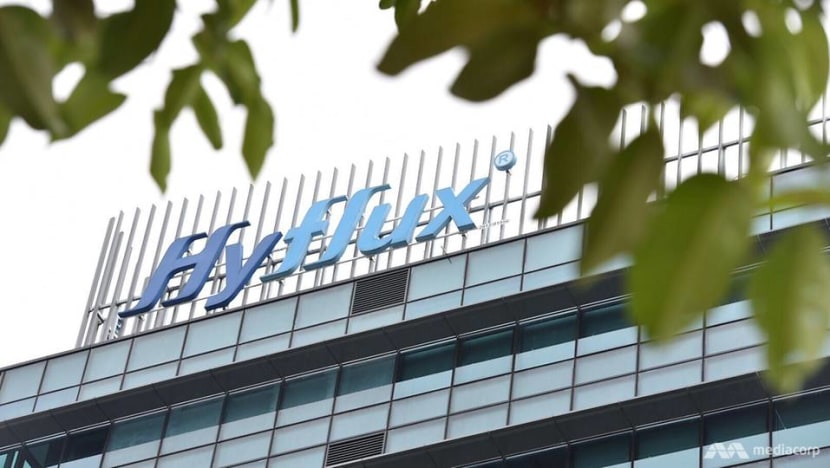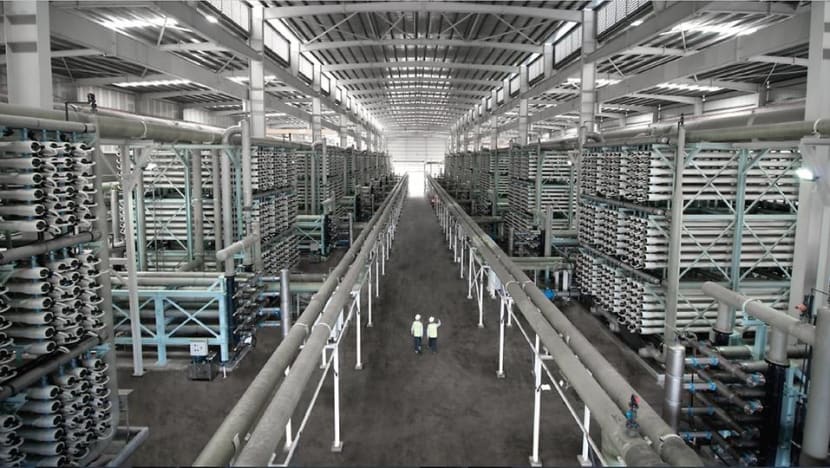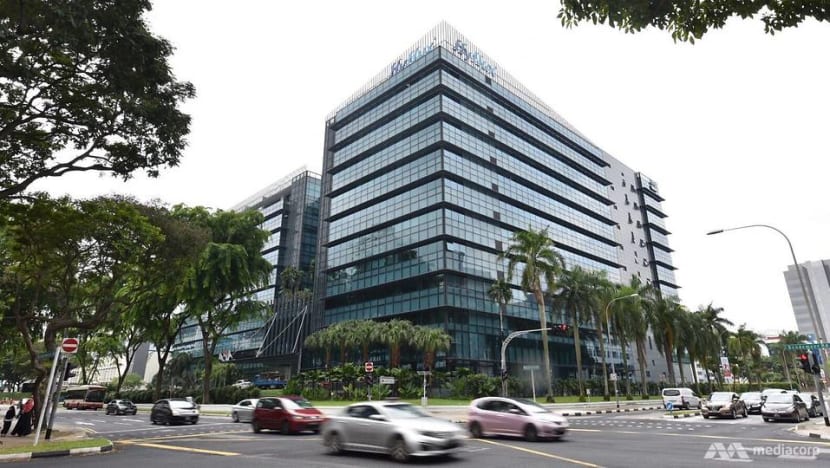commentary Commentary
Commentary: The fall of once-great Hyflux, a unicorn in the Singapore story
There is a good possibility that many bondholders will lose most of their investments in Hyflux and the company will at most exist in a reduced form, says NUS Business School’s Professor Nitin Pangarkar.

Picture of a Hyflux sign. (Photo: Jeremy Long)
SINGAPORE: I have been following with great interest the events surrounding Hyflux over the last few months. For many years, the company and its founder, Olivia Lum, were held up as examples of a successful home-grown company and an outstanding entrepreneur respectively.
That the company was in the water sector, a critical resource for Singapore and increasingly the rest of the world, was an added plus, when it implied the company was serving the nation and “doing good” while doing well.
NOT PRETTY
But somewhere in between its astronomical rise and the situation today, the wheels came off the wagon.
There is a good possibility that many bondholders will lose most of their investments in Hyflux and the company will exist in a reduced form – that is if it manages to survive and secure the necessary support from financial backers and key stakeholders for the proposed restructuring.
The situation is not pretty. Hyflux defaulting on its bondholders has been discussed extensively in the media. A recent report suggests that the PUB has also served a notice of default on Hyflux, for its potential inability to supply water.
Too bad, Hyflux. Water being a critical resource for Singapore is now a double-edged sword.
I will focus on the non-financial aspects of the Hyflux situation precisely because financial default is the most likely outcome of underlying strategic decisions. My intent is not to find fault with Hyflux’s decisions since hindsight is perfect, but to dissect the problems it faced to glean lessons for the benefit of Hyflux and other Singapore companies.
SHIFT TOWARDS OPERATIONS AND MAINTENANCE
A central premise is that Hyflux took on a greater amount of strategic complexity over time. Some risks of this greater strategic complexity may not have been factored in when decisions were taken while other risks only became apparent over time, because of an evolving environment.

READ: I am deeply saddened for the pain and loss suffered by investors, lenders - Hyflux CEO
Hyflux started with a simple strategy of focusing on being a water treatment specialist, which served it well over its first two decades. All seemed to pan out well in its favour, including listing on the Singapore Exchange, a remarkable feat considering its modest beginnings, and after-tax profits of S$59 million in 2008.
In fact, 2008 was also remarkable because the company was able to grow its sales by 188 per cent - from S$192 million in 2007 to S$554 million, helped by a five-fold increase in revenue from the municipal (or government) sector.
In its 2008 annual report, the company noted that Hyflux membranes and systems had been installed in more than 1,000 plants in over 300 locations worldwide, again an impressive achievement.
But someone in that giant corporation should have spotted obvious early warning signs. Revenue was geographically concentrated, however, with China and Middle East and North Africa (MENA) accounting for 54 per cent and 40 per cent of the total revenue in respectively.
By 2008, Hyflux started placing greater emphasis on its Operations and Maintenance (O&M) business instead of its traditional Engineering, Procurement and Construction (EPC) focus.
One advantage of the former was its stable revenue generation with contract duration of 20 to 30 years.
On the other hand, revenue chunkiness was a key disadvantage of EPC, because it means lumpy and unpredictable annual shareholder returns. So Hyflux began to see advantages in the former and maintained a portfolio of both O&M and EPC contracts.
The downside of chasing after O&M contracts was revealed in the recent news of PUB serving a notice of default on Hyflux. Unlike EPC contracts, where a project is handed off to the client who operates the plant (and hence bears all subsequent risks), O&M contracts would require Hyflux to continue to operate the plant.
If, for any reason, Hyflux’s ability to continue to operate the plant became impaired, given the critical resource that water is, the consequences for Hyflux would be severe.
READ: The Marina Barrage, a dream 20 years in the making, a commentary
TUASPRING THE STRAW THAT BROKE THE CAMEL’S BACK?
A major increase in strategic complexity occurred when Hyflux took on the Tuaspring project.
While the capital intensity of the Tuaspring project has been discussed extensively, the strategic implication was that taking on the business pushed Hyflux into a new market: Power generation.

Though there may be some synergies across the water-desalination and power projects, like many diversification decisions where perceived synergies may be emphasised more than the downsides in evaluating project risk, the risks in the power project may have been underestimated - or possibly even overlooked.
Two factors may have further complicated the risk assessment. First, the location of Tuaspring in its Singapore home market may have led to an underestimation of the risks because Hyflux was familiar with the context, unlike many of its projects which were in emerging economies that imply significant uncertainty.
Funding infrastructure projects in the latter category would also require political risk insurance, encouraging Hyflux to exercise project discipline.
READ: What Singapore can do to prepare for the next flood, a commentary
As later events showed, however, the Singapore Government can be a demanding customer. Failure to deliver on its commitments would probably imply a swifter penalty to be imposed.
Second, the deregulation of the power sector culminating in the Open Electricity Market may be another factor that exposed Hyflux’s power sector to the wild fluctuations of commodity prices. As luck would have it, the gyrations in oil prices have been more pronounced over the last few years.
EROSION OF FINANCIAL HEALTH
While strategic complexity rose, a number of other factors were slowly but surely eroding Hyflux’s financial health. Its revenue was erratic — between 2012 and 2016, revenue fluctuated between S$321 million (2014) and S$986 million in 2016.
Clearly, despite greater emphasis on O&M, revenue had not stabilised. For an asset-based company like Hyflux, erratic revenue tends to have a disproportionately large impact on profits because costs are less flexible than revenue.
In fact, the earning per share showed a steady downward trend after 2012, before turning negative in 2016. Even in 2016 when Hyflux reported record revenues, profits were rather modest — in fact, they exhibited a decline over the years prior to 2016.
Through these years, Hyflux’s capital intensity rose with its asset base ballooning from S$2.1 billion in 2012 to S$3.8 billion in 2016. The increased asset base was financed by issuing debt which carried a high interest rate and drained valuable cash.

Though Hyflux’s dividend per share peaked in 2010 at 4.77 cents, the company had to cut it drastically in 2016. Dividend payments would represent another drain on cash.
MIND THE RISKS
So, what are the lessons from the Hyflux story? The most important lesson is: Mind the risks. Diversification is an important growth strategy for many firms but is not a panacea when risk evaluations tend to overemphasise synergies and downplay risks.
Some of the risks also can become magnified over time — as borne out in the case of the power sector.
READ: Are Singapore businesses just not creative enough? A commentary
A second important lesson is about minding small changes in the environment that might cumulatively have a huge impact on your strategy and its viability.
A number of changes have taken place on top of the deregulation of the power sector that had huge impact on Hyflux, including fluctuating fortunes for economies in the Middle East, a key source of revenue for Hyflux before 2012 and reduced orders from Chinese customers, which used to be Hyflux’s biggest market.
Though each of these changes was not large enough to undermine Hyflux, their collective impact on Hyflux was substantial.
READ: For explosive growth, look to these two models of business, a commentary
A third and final lesson is about preparing for the worst-case scenario, especially when large, capital-intensive strategic projects are financed with debt.
Looking ahead, even if Hyflux is able to win a reprieve from bondholders, it faces the possibility of PUB taking over the plant because non-performance of a strategic plant may be viewed as a national security issue.
One hopes this is not the end of the story for this rare Singapore unicorn.
Nitin Pangarkar is an Associate Professor in the Department of Strategy and Policy at the National University of Singapore (NUS) Business School. The opinions expressed are those of the writer and do not represent the views and opinions of NUS.
Editor’s Note: An earlier version of this commentary mentioned Tuas Power. It should have been Tuaspring. We apologise for the error.















